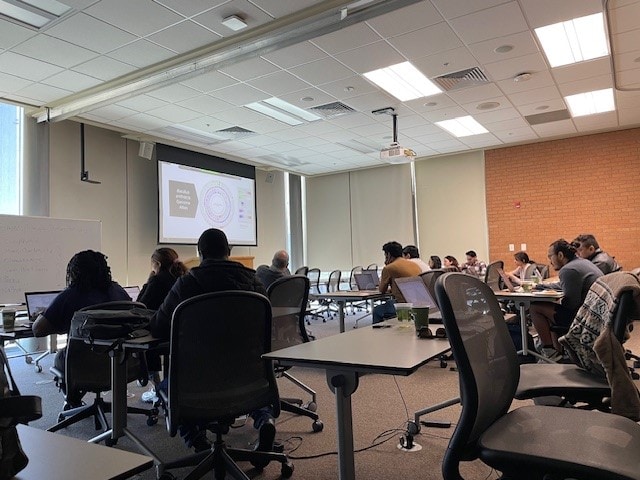UAMS Genomics Workshop Highlights Healthcare Benefits of Artificial Intelligence
| A workshop held March 18-20 attracted undergraduate students, graduate students and faculty from institutions across the state to the University of Arkansas for Medical Sciences (UAMS) to learn about genome sequencing.
About 30 graduate students and faculty members attended in person, while another 30 joined online. They listened to lectures during the first two days, and some made their own presentations on the final morning.
A lecture presented by David Ussery, Ph.D., a professor in the College of Medicine Department of Biomedical Informatics, introduced the workshop participants to a new vocabulary for measuring increasingly large amounts of data. For example, 1,000 zettabytes equal a yottabyte, 1,000 exabytes equal a zettabyte, 1,000 petabytes equal an exabyte and 1,000 terabytes equals a petabyte.
Ussery says this “explosion in sequence data” can be alarming when one considers how the human brain can ever process that much information in a useful way. He said Artificial Intelligence (AI) is necessary to provide a platform of assembled knowledge on which other researchers can expand, without having to go through all the preliminary machinations.
Increasingly large super computers are needed to contain the massive amount of assembled data and allow it to be easily accessed and expanded on, he said.
On the second day of the workshop, Ussery shared a link to a just-published article by the Novo Nordisk Foundation that said Denmark is collaborating with Nvidia, an American multinational corporation that is a world leader in AI computing, to establish a national center for AI innovation “that will house one of the world’s most powerful AI supercomputers.”
“The goal,” the article said, “is to accelerate research and innovation in fields from health care and life sciences to the green transition, supporting the development of innovative solutions to the world’s biggest problems.”
It quoted Mads Krogsgaard Thomsen, CEO of the Novo Nordisk Foundation, as saying, “Groundbreaking scientific discoveries are based on data, and AI has now provided us with an unprecedented opportunity to accelerate research within, for example, human and planetary health. Drug discovery, disease diagnosis and treatment … are examples of areas where extreme AI computing power can enable the positive transformation of our society.”
“I showed the news story to the students and pointed out that the reason Novo Nordisk was willing to help build the largest computer in the world was for ‘life science’ applications and health care,” Ussery said. “Not physics or astronomy or AI, but to deal with the explosion in biological sequence information.”
Ussery noted that while some fear the increasingly widespread use of AI, he isn’t among them. He said he uses it to consolidate some of his own research papers, saving time for additional research, and he appreciates it when students use it to enhance their research capabilities.
“I cannot do my research in high-throughput comparative genomics without access to scientific computing capabilities” that are provided by high-performance computers at UA Fayetteville and others, as part of a large National Science Foundation grant,” he said.
The presentations some participants gave on the last morning of the workshop compared bacterial genomes.
“Several of the students told me that they used Chat-GPT to help them install and get working the R-BioTools software that we used for the course,” Ussery said. “From my perspective, this is a good, productive use of Chat-GPT for help in troubleshooting things like getting programs to work.”
Genomes are all the genetic information of an organism, and genetic sequencing is the process of determining the entire genetic makeup of an organism or cell type, to find changes that can help scientists understand how specific diseases form, as well as how to diagnose and treat disease. Ussery said his research team compares bacterial genomes to look for disease outbreaks.
The genomics workshops, presented annually at UAMS during spring break, are now in their seventh year. They are sponsored by the Arkansas IDeA Network of Biomedical Research Excellence (INBRE), a National Institutes of Health-funded program based at UAMS to expand and strengthen knowledge about biomedical research.
Elizabeth Pierce, Ph.D., chair of the Department of Information Science at the University of Arkansas at Little Rock, coordinated the event. UA Little Rock has a subaward for outreach and education in bioinformatics, a field of science that develops methods and software tools to understand biological data and works with human genomes to study human health and biology.
She said genome sequencing has many applications for human health, including drug design, personalized medicine and analysis of cancer cells. She said bioinformatics also has applications in many other fields such as environment science, animal sciences, agriculture and waste management.
In fact, several participants at this year’s workshop came from the poultry sciences, where learning about genomics can help improve the breeding, management of bird health and quality of the meat produced. Promoting genetic diversity in agriculture, livestock and nature can have a wide range of benefits including enhanced resistance against diseases, climate change and long-term sustainability.
One of Ussery’s former students, Visanu Wanchai, Ph.D., gave a workshop lecture on how to install and use R-BioTools. Visanu now is doing myeloma research in the UAMS Winthrop P. Rockefeller Cancer Institute.
Among the institutions from which the attendees participated were UA Little Rock and the University of Arkansas at Pine Bluff and Hendrix College in Conway. According to information they supplied, they are studying a range of subjects including data analysis, genomics, molecular gene functions and microbiome research, Parkinson’s Disease and other neurological diseases, genetics, genetic engineering, bioinformatics, hereditary diseases, drought tolerance in tomatoes, eating disorders and cancer development.
